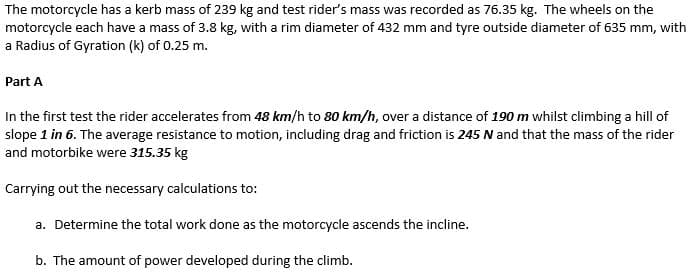The motorcycle has a kerb mass of 239 kg and test rider's mass was recorded as 76.35 kg. The wheels on the motorcycle each have a mass of 3.8 kg, with a rim diameter of 432 mm and tyre outside diameter of 635 mm, with a Radius of Gyration (k) of 0.25 m. Part A In the first test the rider accelerates from 48 km/h to 80 km/h, over a distance of 190 m whilst climbing a hill of slope 1 in 6. The average resistance to motion, including drag and friction is 245 N and that the mass of the rider and motorbike were 315.35 kg Carrying out the necessary calculations to: a. Determine the total work done as the motorcycle ascends the incline. b. The amount of power developed during the climb.
The motorcycle has a kerb mass of 239 kg and test rider's mass was recorded as 76.35 kg. The wheels on the motorcycle each have a mass of 3.8 kg, with a rim diameter of 432 mm and tyre outside diameter of 635 mm, with a Radius of Gyration (k) of 0.25 m. Part A In the first test the rider accelerates from 48 km/h to 80 km/h, over a distance of 190 m whilst climbing a hill of slope 1 in 6. The average resistance to motion, including drag and friction is 245 N and that the mass of the rider and motorbike were 315.35 kg Carrying out the necessary calculations to: a. Determine the total work done as the motorcycle ascends the incline. b. The amount of power developed during the climb.
International Edition---engineering Mechanics: Statics, 4th Edition
4th Edition
ISBN:9781305501607
Author:Andrew Pytel And Jaan Kiusalaas
Publisher:Andrew Pytel And Jaan Kiusalaas
Chapter7: Dry Friction
Section: Chapter Questions
Problem 7.11P: Solve Prob. 7.10 assuming that the pick-up truck has front-wheel drive.
Related questions
Question
If you could please advise with this question, showing orking out of possible, Thank you. If you need any extra credts for the question then please let me know

Transcribed Image Text:The motorcycle has a kerb mass of 239 kg and test rider's mass was recorded as 76.35 kg. The wheels on the
motorcycle each have a mass of 3.8 kg, with a rim diameter of 432 mm and tyre outside diameter of 635 mm, with
a Radius of Gyration (k) of 0.25 m.
Part A
In the first test the rider accelerates from 48 km/h to 80 km/h, over a distance of 190 m whilst climbing a hill of
slope 1 in 6. The average resistance to motion, including drag and friction is 245 N and that the mass of the rider
and motorbike were 315.35 kg
Carrying out the necessary calculations to:
a. Determine the total work done as the motorcycle ascends the incline.
b. The amount of power developed during the climb.
Expert Solution
This question has been solved!
Explore an expertly crafted, step-by-step solution for a thorough understanding of key concepts.
Step by step
Solved in 2 steps with 2 images

Knowledge Booster
Learn more about
Need a deep-dive on the concept behind this application? Look no further. Learn more about this topic, mechanical-engineering and related others by exploring similar questions and additional content below.Recommended textbooks for you

International Edition---engineering Mechanics: St…
Mechanical Engineering
ISBN:
9781305501607
Author:
Andrew Pytel And Jaan Kiusalaas
Publisher:
CENGAGE L

International Edition---engineering Mechanics: St…
Mechanical Engineering
ISBN:
9781305501607
Author:
Andrew Pytel And Jaan Kiusalaas
Publisher:
CENGAGE L